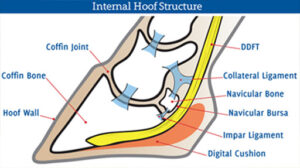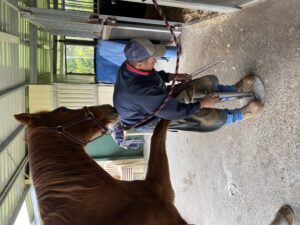Navicular Syndrome in Horses
Also known as Navicular Disease, Caudal Heal Pain & Podotrochlosis
No matter what you call it, the word Navicular causes the heart of any horse owner to sink. It means lameness and it can be career ending. Navicular is like colic in that it has many different causes and may affect different areas of the foot. It is called Navicular because it usually affects the navicular bone inside the hoof, but it may also affect the surrounding soft tissue structures. These structures together are known as the Navicular Apparatus, and they include the navicular bone, the navicular bursa, the coffin joint, the impar ligament, the suspensory ligaments, laminae of the heels, and the deep digital flexor tendon (DDFT).

These structures may become damaged from:
- Injury
- Age related deterioration
- Poor conformation (long toes and underrun heals)
- Breed related (Thoroughbreds, Warmbloods, and Quarter Horses are more prone)
When any of these structures become damaged, they will cause pain and lameness. Unfortunately, this is a degenerative process which means the lameness will likely get worse instead of better with time. There is no cure for navicular, you can only manage and treat the symptoms. At the start of the process your horse may only show intermittent lameness or may work out of the lameness after warming up, but without proper care and early intervention it will get worse. The earlier you can spot the signs of navicular the better the treatment outcomes will be.
Early signs of navicular changes may include:
- Intermittent front limb lameness
- Lameness in a small circle
- Shortened stride
- Sensitive on hard surfaces
- Reluctant to put heals on the ground
Your veterinarian will diagnose navicular by performing a lameness work up that may include radiographs, ultrasound, or even an MRI. Your veterinarian will then likely recommend a qualified farrier to trim your horses’ hooves in a way that will relieve the pressure off the heals and then apply corrective shoes to reduce the pressure even more. Your veterinarian may also recommend pain relieving medication if the lameness is severe or if shoeing does not greatly improve the lameness.

Things you can do to help your horse with navicular:
- Keep shoes clean and free of debris as much as possible to help reduce pressure on the navicular area.
- Lots of turn out time. To help improve circulation to the affected area, it is very important that horses are stabled as little as possible.
- Maintain a healthy body condition score. Overweight horses will cause more pressure on the navicular area.
- Make sure your horse has a balanced diet to help with hoof health and strength. (Ranvet’s Hoof Food in the diet may help with hoof strength and integrity of the hoof structures.)
- Try to work your horse on soft surfaces.
- Try not to work in tight circles. Warm up in straight lines as much as possible. No lunging.
With early detection and proper care and maintenance with the help of your veterinarian and farrier, hopefully your navicular horse will be able to have a comfortable useful life for many more years to come.
Experts in Equine Nutrition
Every product in the Ranvet range has been developed to meet a horse’s most specific need at any given time, be it in a training environment or on a breeding farm. Having pioneered the formulation of specific medications and dietary supplements for horses, the company is now recognised as a leader in the areas of equine health and nutrition.
